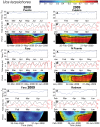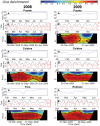Reproducing on time when temperature varies: shifts in the timing of courtship by fiddler crabs
- PMID: 24832079
- PMCID: PMC4022618
- DOI: 10.1371/journal.pone.0097593
Reproducing on time when temperature varies: shifts in the timing of courtship by fiddler crabs
Abstract
Many species reproduce when conditions are most favorable for the survival of young. Numerous intertidal fish and invertebrates release eggs or larvae during semilunar, large amplitude, nocturnal tides when these early life stages are best able to escape predation by fish that feed near the shore during the day. Remarkably, some species, including the fiddler crabs Uca terpsichores and Uca deichmanni, maintain this timing throughout the year as temperature, and thus the rate of embryonic development, vary. The mechanisms that allow such precision in the timing of the production of young are poorly known. A preliminary study suggested that when temperature decreases, U. terpsichores mate earlier in the tidal amplitude cycle such that larvae are released at the appropriate time. We tested this idea by studying the timing of courtship in U. terpsichores and U. deichmanni as temperature varied annually during two years, at 5 locations that differed in the temperature of the sediment where females incubate their eggs. Uca terpsichores courted earlier at locations where sediment temperature declined seasonally but not where sediment temperature remained elevated throughout the year. In contrast, clear shifts in courtship timing were not observed for U. deichmanni despite variation in sediment temperature. We discuss other mechanisms by which this species may maintain reproductive timing. These two species are likely to be affected differently by changes in the frequency and intensity of cold periods that are expected to accompany climate change.
Conflict of interest statement
Figures






Similar articles
-
Timing of hatching and release of larvae by brachyuran crabs: patterns, adaptive significance and control.Integr Comp Biol. 2011 Jul;51(1):62-72. doi: 10.1093/icb/icr013. Epub 2011 May 18. Integr Comp Biol. 2011. PMID: 21593141 Review.
-
Sexual selection and the physiological consequences of habitat choice by a fiddler crab.Oecologia. 2014 Sep;176(1):25-34. doi: 10.1007/s00442-014-3002-y. Epub 2014 Jul 6. Oecologia. 2014. PMID: 24997775
-
Courtship herding in the fiddler crab Uca elegans.J Comp Physiol A Neuroethol Sens Neural Behav Physiol. 2008 Dec;194(12):1053-61. doi: 10.1007/s00359-008-0376-5. Epub 2008 Oct 10. J Comp Physiol A Neuroethol Sens Neural Behav Physiol. 2008. PMID: 18846353
-
Is female preference for large sexual ornaments due to a bias to escape predation risk?BMC Evol Biol. 2012 Mar 13;12:33. doi: 10.1186/1471-2148-12-33. BMC Evol Biol. 2012. PMID: 22413838 Free PMC article.
-
The visual ecology of fiddler crabs.J Comp Physiol A Neuroethol Sens Neural Behav Physiol. 2006 Jan;192(1):1-25. doi: 10.1007/s00359-005-0048-7. Epub 2005 Dec 10. J Comp Physiol A Neuroethol Sens Neural Behav Physiol. 2006. PMID: 16341863 Review.
Cited by
-
Multimodal communication in courting fiddler crabs reveals male performance capacities.R Soc Open Sci. 2017 Mar 15;4(3):161093. doi: 10.1098/rsos.161093. eCollection 2017 Mar. R Soc Open Sci. 2017. PMID: 28405396 Free PMC article.
-
Reproductive cycles in tropical intertidal gastropods are timed around tidal amplitude cycles.Ecol Evol. 2017 Jun 23;7(15):5977-5991. doi: 10.1002/ece3.3166. eCollection 2017 Aug. Ecol Evol. 2017. PMID: 28808559 Free PMC article.
-
Temporal Patterns of Larval Fish Occurrence in a Large Subtropical River.PLoS One. 2016 Jan 13;11(1):e0146441. doi: 10.1371/journal.pone.0146441. eCollection 2016. PLoS One. 2016. PMID: 26760762 Free PMC article.
References
-
- Harley CDG, Randall Hughes A, Hultgren KM, Miner BG, Sorte CJB, et al. (2006) The impacts of climate change in coastal marine systems. Ecology Letters 9: 228–241. - PubMed
-
- Kordas RL, Harley CDG, O'Connor MI (2011) Community ecology in a warming world: The influence of temperature on interspecific interactions in marine systems. Journal of Experimental Marine Biology and Ecology 400: 218–226.
-
- Parmesan C (2006) Ecological and Evolutionary Responses to Recent Climate Change. Annual Review of Ecology, Evolution, and Systematics 37: 637–669.
-
- Walther GR, Post E, Convey P, Menzel A, Parmesan C, et al. (2002) Ecological responses to recent climate change. Nature 416: 389–395. - PubMed
Publication types
MeSH terms
LinkOut - more resources
Full Text Sources
Other Literature Sources

